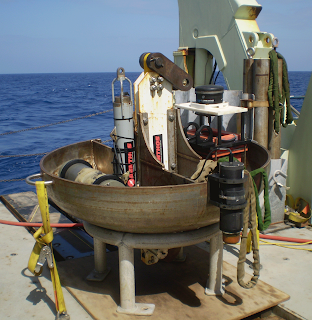
There is a lot of interest in (and more than a few questions about) the long coring operation, so I decided to post this pictorial essay of the long core operation. I've included a few figure captions to lead the way. As a start, the diagram to the right illustrates the basic set-up: the long core is first lowered to vertical, then moved to the back of the ship for deployment.
Thanks go to Cleverson and Gary for most of the photos that follow.
When not in use, the long core rests (and is rested upon) on its perch along the starboard railing.


Before coring can commence, the 3-meter-long pieces of liner are pre-marked (section one is the bottom -- deepest-- section) and then inserted into the core barrel.
The corer is carefully lifted off its perch . . .
. . . and lowered into a vertical position at the stern of the ship.
The corer will be attached to the "dog dish" and lowered via a cable that is fed through this slot in the stern deck.
The next series of photos show this happening.
The next series of photos show this happening.
Done!
Now we move inside to watch the action on the monitor. The scientists join in this fun too. All eyes are on the wench tension.
Once the corer reaches the bottom it is "released" and plows through the seafloor, picking up sediment as it goes. It is then brought back on board, placed in its perch on the starboard railing, and extruded.
The core is extruded (pushed from the top by the folks in the "man basket" that hangs out behind the ship); the liner sections are separated, cleaned, and capped;
and the sections are brought into the main lab, where they degasses as they await logging.
and the sections are brought into the main lab, where they degasses as they await logging.
If you want to see the long coring operation in even more detail (and with action), check out the long coring video on the WHOI website (also available in a QuickTime version).





























No comments:
Post a Comment